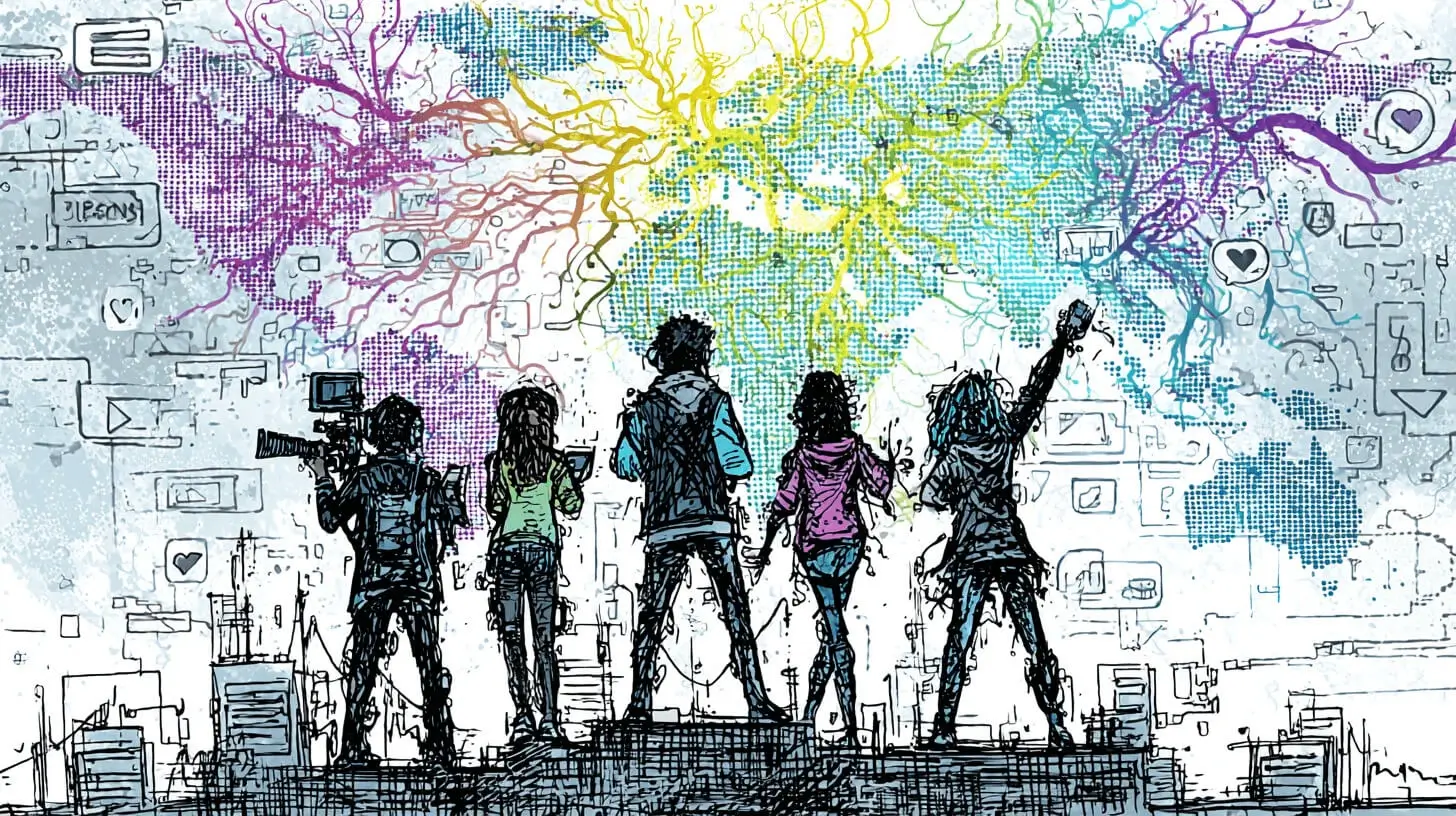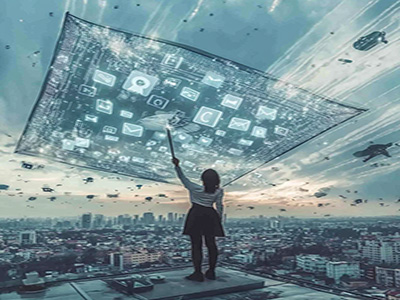The way we connect with each other has undergone a dramatic transformation over the past few decades. What once required physical presence or handwritten letters has now been taken over by digital platforms that allow instant communication across the globe. As technology continues to break through traditional barriers, we find ourselves living in an era where distance has become virtually irrelevant in human interaction. The evolution from simple telephone calls to sophisticated digital ecosystems has fundamentally altered how we share information, maintain relationships, and conduct business.
Human Communication
Life in Movement. Language in Full.
The Digital Revolution and the Transformation of Lives
🎧Hit play and watch phrasal verbs come alive in real-life
Weekly Cross
Evolution of Human Communication
🎙️ Podcast (Audio)
Life and changes
we invite you to think about how life has changed — and how the language we use reflects those changes.
How Modern Communication Shapes Our Lives

The Birth of the Internet: A Communication Revolution
The internet's emergence brought about the most significant shift in human communication since the invention of the printing press. Early pioneers worked tirelessly to set up the foundational infrastructure that would eventually link up computers worldwide. When the World Wide Web was first introduced, few could have predicted how it would catch on with the general public.
The initial skepticism quickly wore off as people began to pick up the potential for instant global communication. Universities and research institutions were among the first to sign up for internet access, recognizing its potential to speed up research collaboration and information sharing.
The Personal Computer Boom: Making Technology Accessible
The 1980s and 1990s witnessed personal computers taking off in households across the developed world. Companies like Apple and Microsoft worked to come up with user-friendly interfaces that would help ordinary people get around the complexities of computing. As prices began to go down, more families could afford to purchase these machines. Computer literacy programs sprang up in schools and community centers, helping people brush up on their technical skills. The intimidation factor that once put people off computers gradually disappeared as manufacturers came out with more intuitive designs. Software developers kept up with consumer demands, creating applications that would make up for the lack of technical expertise among everyday users.
The democratization of computing technology led to unprecedented access to information and communication tools. Families would gather around their home computers to explore this new digital frontier, while businesses relied on these machines to carry out operations more efficiently. The ability to store up vast amounts of data and call up information instantly revolutionized how we work and learn. Soon, the concept of logging on to a computer network became as routine as picking up a telephone.

The Mobile Revolution: Communication in Your Pocket

Evolution
The introduction of mobile phones brought on another wave of communication evolution. Early adopters were quick to show off their bulky devices, even though the technology was still catching up to user expectations. Network providers had to build up extensive infrastructure to keep up with growing demand. As mobile technology moved on from simple voice calls to text messaging, people found new ways to reach out to each other throughout the day. The convenience of being able to get in touch with anyone, anywhere, ruled out the need for many traditional communication methods.
Smartphones came along and completely transformed the mobile landscape. These devices combined multiple functions, allowing users to look up information, send out messages, and connect to the internet from virtually anywhere. The ability to download applications meant that phones could adapt to individual user needs. Social media platforms took advantage of this mobility, creating apps that would keep users engaged throughout the day. The phenomenon of checking in on social media and posting updates became routine behaviors that fit into daily life seamlessly.
Democracy Goes Digital: The New Face of Media
The Power of Oral Tradition
Digital media platforms burst onto the scene in the early 2000s, fundamentally changing how information is created, shared, and consumed. Traditional media outlets had to adapt to this new landscape or risk being left behind. News organizations branched out into digital formats, learning to put out content at unprecedented speeds. The ability to tune into live events from anywhere in the world meant that global awareness went up dramatically. Social media platforms opened up new possibilities for citizen journalism, allowing ordinary people to point out important events and speak up about issues that mattered to them.
The democratization of content creation gave rise to influencers and independent creators who could build up massive audiences without traditional media gatekeepers. These creators learned to stand out in crowded digital spaces by coming up with unique content strategies. Platforms rolled out sophisticated algorithms designed to match up content with user preferences, helping creators reach out to their target audiences more effectively. The speed at which information could spread out across networks meant that content could blow up overnight, creating viral phenomena that took over popular culture.

The Advantages: Connection and Information Democracy
Digital media has brought together people from diverse backgrounds who might never have come across each other otherwise. Online communities spring up around shared interests, allowing individuals to connect with like-minded people regardless of geographical constraints. Educational content has opened up learning opportunities that were previously cut off from many due to economic or geographic barriers. The ability to look up information instantly has done away with many traditional research limitations, allowing people to keep up with developments in their fields of interest in real-time.
The speed of information dissemination means that important news can get out to the public before traditional media outlets can catch up. This has led to greater transparency in many areas of public life, as it becomes harder for institutions to cover up problematic behaviors. Social movements can pick up momentum quickly when they tap into widespread concerns, using digital platforms to bring about social change. The ability to back up claims with easily accessible evidence has strengthened public discourse in many ways.

Great Progress! 📈
You've already explored 65% of this topic. Keep going on your journey!

The Dark Side: Privacy, Misinformation, and Isolation
The Power of Oral Tradition
However, the digital revolution has also brought up serious concerns about privacy and data security. Companies gather up vast amounts of personal information, often without users fully understanding what they're signing up for. Data breaches crop up regularly, putting sensitive information at risk. The business models of many platforms rely on collecting and monetizing user data, creating incentives that don't always line up with user interests. Governments and corporations have taken advantage of these data collection capabilities, sometimes stepping over privacy boundaries that many consider fundamental rights.
The phenomenon of misinformation has taken off in the digital age, with false information able to spread out faster than fact-checkers can keep up with it. Bad actors make up convincing-looking fake news stories that play on people's emotions and biases. Social media algorithms, designed to keep users engaged, often pick up on controversial content and push it out to wider audiences. The echo chamber effect means that people end up consuming information that backs up their existing beliefs, making it harder to break through to those who have bought into false narratives.

The Loss of Authentic Human Connection
Despite unprecedented connectivity, many people report feeling more isolated than ever. The convenience of digital communication has cut down on face-to-face interactions, leading some to miss out on the nuances of in-person communication. While digital platforms open up new possibilities for connection, they can also water down the quality of our relationships. The constant pressure to keep up with online personas can wear people down, creating anxiety and social pressure that builds up over time.
The phenomenon of "digital relationships" has taken over many aspects of social interaction, but these connections often fall short of providing the emotional depth that comes with in-person relationships. People get caught up in maintaining their online presence, sometimes putting off real-world social activities. The addictive nature of social media platforms means that people give in to the urge to check up on others constantly, but this behavior often leads to feelings of inadequacy and social comparison rather than genuine connection.
Finding Balance in the Digital Age
As we move forward in this digital era, it's crucial to figure out how to make the most of technology's benefits while guarding against its potential harms. Educational initiatives that focus on digital literacy can help people sort out reliable information from misinformation. Privacy-focused technologies are coming along that may help users opt out of excessive data collection while still taking advantage of digital services' benefits.
The key is learning to set up healthy boundaries with technology rather than giving up on it entirely. This might involve cutting back on social media usage, seeking out more face-to-face interactions, or speaking up about privacy concerns. As digital natives grow up with these technologies, they're working out new social norms that balance out online and offline experiences.

📱 Digital Age Phrasal Verbs Bank
⚠️ Digital Problems & Risks
Phrasal verbs describing digital issues, threats, and negative consequences
🛡️ Solutions & Protection
Phrasal verbs related to solving problems and protecting oneself digitally
👤 Digital Behaviors
Phrasal verbs describing how people act and interact in digital spaces
📈 Growth & Progress
Phrasal verbs indicating development, improvement, and forward movement
Conclusion: Navigating Our Connected Future

The digital revolution has brought about unprecedented changes in how we communicate, access information, and relate to one another. While these technologies have opened up remarkable opportunities for connection and learning, they have also given rise to new challenges that we must deal with thoughtfully. As we look ahead to future developments, it's important to keep in mind both the promises and perils of our increasingly connected world.
The responsibility falls on individuals, communities, and institutions to work together in bringing about a digital future that serves humanity's best interests. This means standing up for privacy rights, calling out misinformation, and making sure that technology adds to rather than takes away from our human connections. By staying aware of these issues and taking action when necessary, we can make sure that the digital revolution turns out to be a positive force for human flourishing.
As we continue to adapt to this rapidly changing landscape, the most important thing is to hold onto our capacity for genuine human connection while embracing the tools that can help us build a more informed, connected, and empathetic world. The future will depend on our ability to balance technological innovation with human values, ensuring that progress serves people rather than the other way around.
